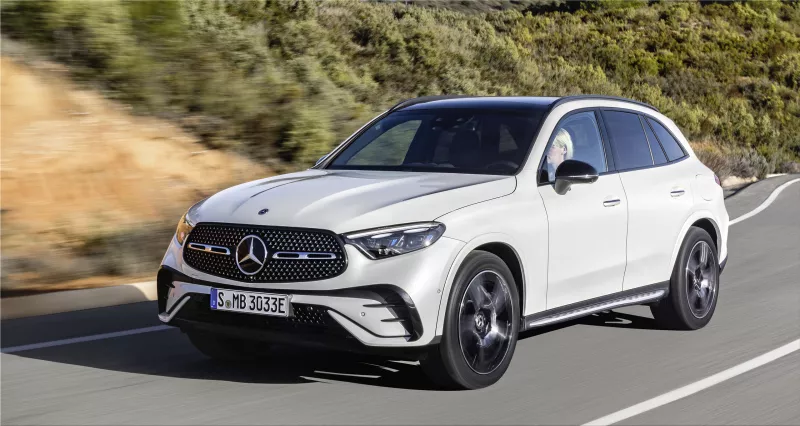Mercedes-Benz has introduced the latest generation of its popular SUV model, the GLC. Only electric drives are utilized, which necessitates a 48-volt mild-hybrid minimum. The car range of three plug-in hybrids exceeds 100 kilometers each. The new Mercedes-Benz-developed battery is the heart of all three plug-in hybrids. It has a capacity of 31,2 kWh in total.
Optionally, the maximum DC charging power of the GLC PHEV is 60 kW. So even with a completely depleted battery, charging should take approximately 30 minutes. Depending on the market, a standard 11 kW charger is included on the AC side. Mercedes doesn't say how long it takes to charge in the press release, but with the right charging station or wall box, it should take a little less than three hours.
Since the battery's power density has increased, DC charging can also cause an increase in cell temperature, so the new battery has an internal cooling system. This should improve the DC charging curve and enable continuous operation in both hot and cold climates. Mercedes states that the maximum torque of the electric motor (permanently excited synchronous type) is 440 Nm. The electric motor's output is 100 kW across all variants. This enables the GLC to travel at up to 140 km/h on electric power alone.
One of the development objectives was to create a significantly more electric driving experience and a longer e-range. Mercedes asserts that it has enhanced the hybrid driving program. The electric driving mode automatically activates the route's most sensible segments.
Additionally, a new vacuum-independent, electromechanical brake booster will enhance the electric driving experience and efficiency. Mercedes claims this system automatically controls the flexible switch between hydraulic braking and recovery based on driving conditions to maximize energy recovery. The system is made to use better the maximum amount of power that can be recovered, which is also 100 kW.
The electric drive is combined with two gasoline engines or one diesel engine. In all cases, these are two-liter, four-cylinder engines, and the mild hybrids also feature a six-cylinder engine. The gasoline engine in the Mercedes-Benz GLC 300 e 4MATIC produces 150 kW, and the system output is 230 kW. Mercedes cites a system output of 280 kW for the GLC 400 e 4MATIC. The Mercedes-Benz GLC 400 e 4MATIC has 185 kW of gasoline power. The system output of the GLC 300 4MATIC is 245 kW, with the diesel contributing 145 kW.

The diesel PHEV has the greatest system torque at 750 Nm, while the gasoline models have 550 and 650 Nm, respectively. Moreover, the e-range for the two gasoline models is 104 to 120 kilometers, while for the diesel, it is 102 to 117 kilometers.
Due to the GLC's frequent use as a tow vehicle, Mercedes has also approved the following. The plug-in hybrids can tow up to two tons; the mild-hybrid gasoline vehicles can tow two tons; the mild-hybrid diesel vehicles can tow two tons. In all instances, the drawbar load is 100 kilograms. Another new feature is a trailer route planner that considers drive-through widths and heights.
Standards on the chassis of plug-in hybrids are air suspension and level control on the rear axle. The complete Airmatic system is available for an additional fee. Like the Mercedes-Benz EQE and Mercedes-Benz EQS, rear-axle steering is an option on the Mercedes-Benz GLC. The maximum rear axle steering angle is 4.5 degrees. This makes the turning circle 90 centimeters smaller, making it easier to handle at 10.9 meters.
The new GLC's bodywork has grown by six centimeters to 4,71 meters. The vehicle is slightly narrower from wing mirror to wing mirror but the same height. With a capacity of up to 600 liters, the trunk has grown by 50 liters. The Mercedes-Benz GLC looks like other Mercedes cars, with an 11.9-inch screen taking up most dashboard space.
"With its high level of ride comfort and overall convincing acoustics, the GLC is an excellent long-distance companion and a blast to drive," says Jorg Bartels, Head of Integration, Complete Vehicle. "The new GLC has all the characteristics of a Mercedes-Benz SUV, including uncompromised handling safety on the road, outstanding driving dynamics, and superior off-road performance." Mercedes has not yet announced official pricing.
Mercedes-Benz has also recently laid the symbolic cornerstone for a new research and development center for future generations of batteries and battery cells at its Stuttgart-Untertürkheim headquarters. The Mercedes-Benz eCampus will be gradually implemented beginning in 2023.
Initially, the location will house a factory for the small-scale production of battery cells, according to the automaker. By the "middle of the decade," a battery safety laboratory and various test rigs will be constructed for testing and evaluating new battery generations.
The unspecified multimillion-dollar investment in eCampus is intended to ensure the longevity of the nearly 120-year-old plant. As part of the Group's "Electric Only" strategy, Untertürkheim will change from a plant for engines and amounts to a "high-tech location for drive technologies."
This groundbreaking ceremony represents the future of our traditional location in Stuttgart-Untertürkheim, according to Mercedes-Benz Group CEO Ola Kallenius. "Together with our highly trained and motivated workforce, we are shaping the emergence of a new electric era. Therefore, Untertürkheim will remain the center of Mercedes-Benz's technology in the future. " @via Spare Wheel.







